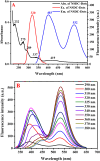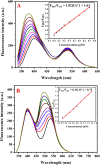Smart fluorometric sensing of metal contaminants in canned foods: a carbon dot-based dual-response system for quantifying aluminum and cobalt ions
- PMID: 40041372
- PMCID: PMC11877424
- DOI: 10.1039/d5ra00448a
Smart fluorometric sensing of metal contaminants in canned foods: a carbon dot-based dual-response system for quantifying aluminum and cobalt ions
Abstract
The leaching of aluminum and cobalt ions into canned foods, such as aluminum from canned tomato sauce and cobalt from canned tuna, raises concerns about potential health risks, making their accurate detection essential for food safety. In this study, we developed a novel ratiometric fluorometric sensor based on dual-emission carbon dots capable of selectively detecting aluminum (Al3+) and cobalt (Co2+) ions after a single excitation. The sensor exhibits distinct fluorescence responses: cobalt ions enhance the emission at 403 nm due to interactions with nitrogen and sulfur groups on the carbon dot surface, while Al3+ enhance the emission at 532 nm through binding with oxygen-rich groups such as carboxyl and hydroxyl. This differential response stems from the varying affinities of these metal ions for different functional groups, as confirmed through mechanistic studies and comprehensive characterization of the carbon dots, including TEM, UV-Vis, FTIR, and fluorescence lifetime analyses. The method demonstrates excellent sensitivity, with limits of detection (LOD) of 0.012 μM for Co2+ and 0.06 μM for Al3+. The sensor's performance was validated with real food samples, successfully determining Al3+ in canned tomato sauce and Co2+ in canned tuna. The method exhibited high selectivity with minimal interference, achieving recovery rates of 97.50-100.67% for Al3+ and 97.01-98.02% for Co2+. These findings underscore the robustness and practical applicability of the proposed sensor as a reliable tool for monitoring Al3+ and Co2+ in canned foods, ensuring food safety and compliance with regulatory standards.
This journal is © The Royal Society of Chemistry.
Conflict of interest statement
There are no conflicts to declare.
Figures






Similar articles
-
Nitrogen, sulfur, and phosphorus Co-doped carbon dots-based ratiometric chemosensor for highly selective sequential detection of Al3+ and Fe3+ ions in logic gate, cell imaging, and real sample analysis.Chemosphere. 2023 Feb;313:137444. doi: 10.1016/j.chemosphere.2022.137444. Epub 2022 Nov 30. Chemosphere. 2023. PMID: 36462566
-
Smartphone-integrated dual-emission fluorescence sensing platform based on carbon dots and aluminum ions-triggered aggregation-induced emission of copper nanoclusters for on-site visual detecting sulfur ions.Anal Chim Acta. 2022 Nov 1;1232:340460. doi: 10.1016/j.aca.2022.340460. Epub 2022 Sep 30. Anal Chim Acta. 2022. PMID: 36257742
-
Cobalt-modulated dual emission carbon dots for ratiometric fluorescent vancomycin detection.RSC Adv. 2024 Feb 14;14(8):5609-5616. doi: 10.1039/d3ra08899e. eCollection 2024 Feb 7. RSC Adv. 2024. PMID: 38357036 Free PMC article.
-
Metal and heteroatoms co-doped fluorescent carbon dots for highly selective and sensitive detection of Mg2+ ions in aqueous media: Applications in test strips, pharmaceutical, real samples and bioimaging.Spectrochim Acta A Mol Biomol Spectrosc. 2025 May 5;332:125851. doi: 10.1016/j.saa.2025.125851. Epub 2025 Feb 8. Spectrochim Acta A Mol Biomol Spectrosc. 2025. PMID: 39923716
-
Novel single excitation dual-emission carbon dots for colorimetric and ratiometric fluorescent dual mode detection of Cu2+ and Al3+ ions.RSC Adv. 2019 Nov 26;9(66):38568-38575. doi: 10.1039/c9ra07030c. eCollection 2019 Nov 25. RSC Adv. 2019. PMID: 35540185 Free PMC article.
Cited by
-
Recent Advances in Carbon-Based Sensors for Food and Medical Packaging Under Transit: A Focus on Humidity, Temperature, Mechanical, and Multifunctional Sensing Technologies-A Systematic Review.Materials (Basel). 2025 Apr 18;18(8):1862. doi: 10.3390/ma18081862. Materials (Basel). 2025. PMID: 40333572 Free PMC article. Review.
-
Trypan Blue-Based Carbon Dots for Sensing of Al3+ in Real Samples and Living Cells.ACS Omega. 2025 May 20;10(21):21463-21472. doi: 10.1021/acsomega.5c00220. eCollection 2025 Jun 3. ACS Omega. 2025. PMID: 40488077 Free PMC article.
References
-
- Stahl T. Taschan H. Brunn H. Environ. Sci. Eur. 2011;23:37.
-
- Mol S. J. Food Compos. Anal. 2011;24:66–69.
-
- Joshi S. P. Toma R. B. Medora N. O'Connor K. Food Chem. 2003;83:383–386.
-
- Lauwerys R. Lison D. Sci. Total Environ. 1994;150:1–6. - PubMed
LinkOut - more resources
Full Text Sources

